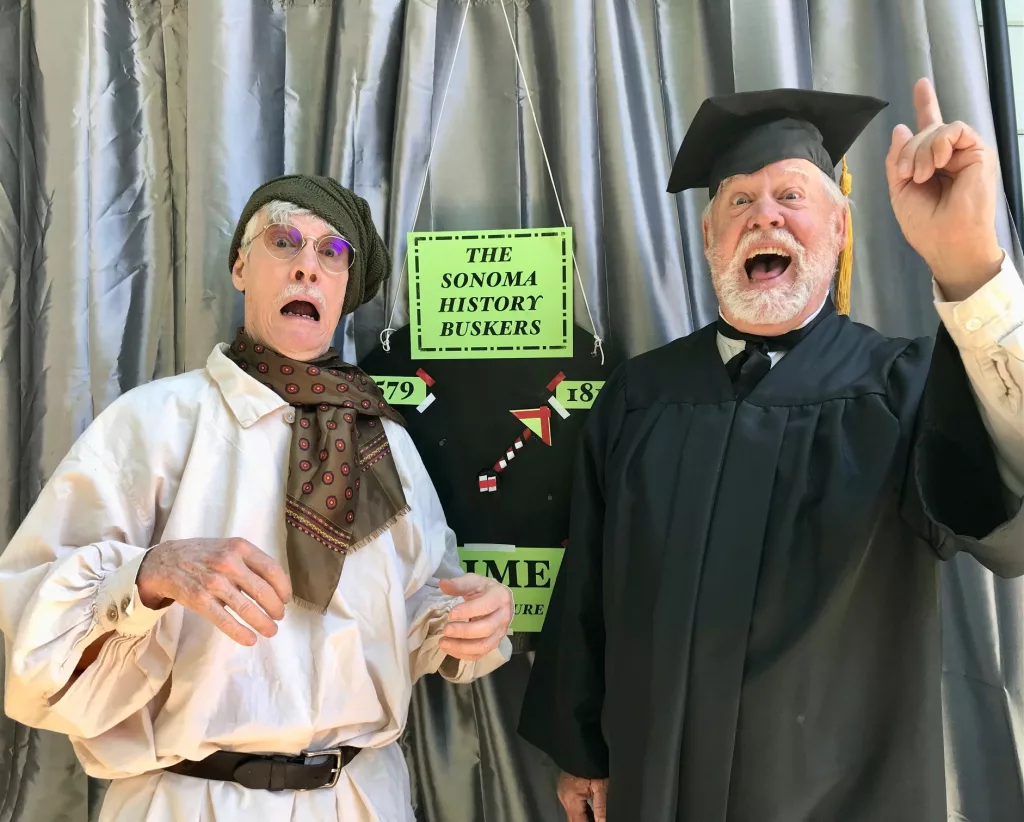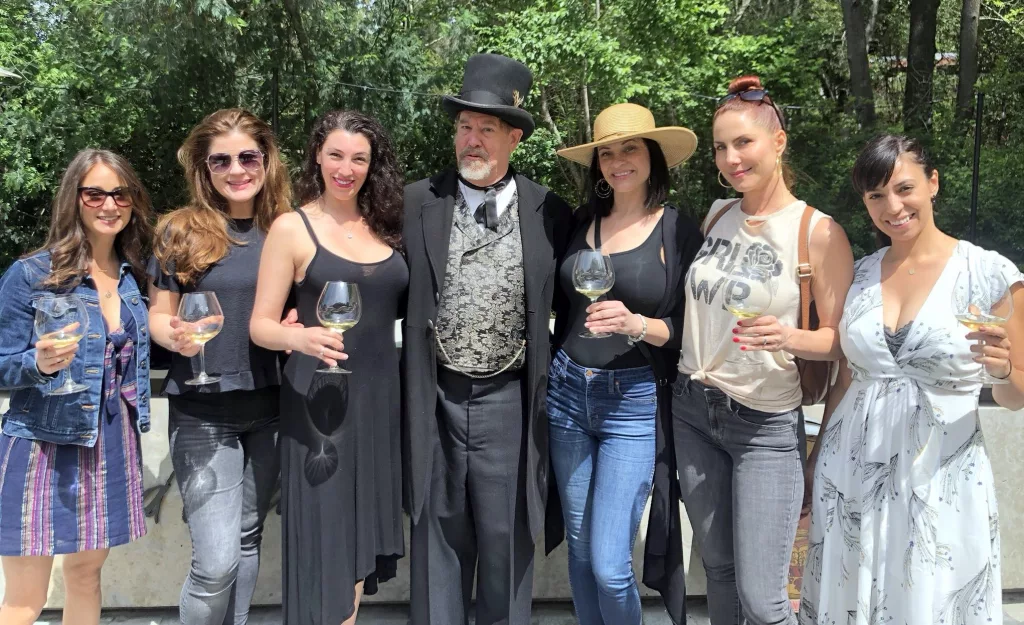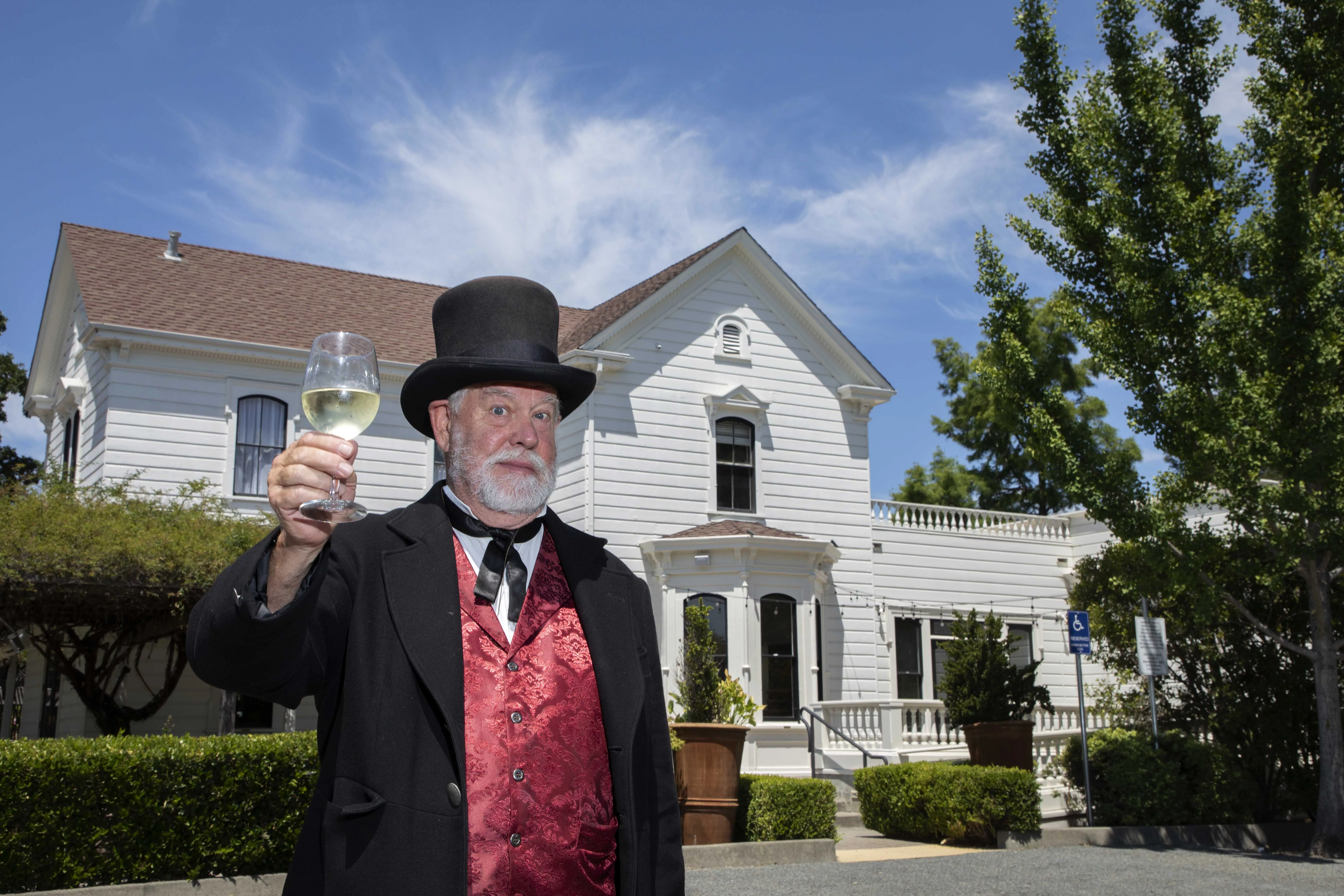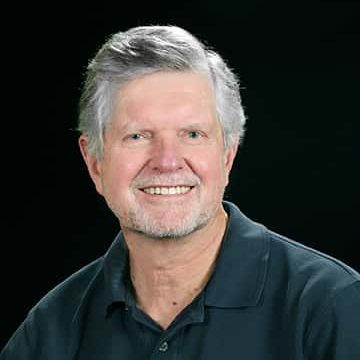
A little knowledge goes a long way: George Webber knows wine, history, and acting.
George Webber is a Wine Country icon. Attired in a top hat, red velvet vest, high-collared white shirt, black tie and cane, he’s a familiar figure around Sonoma Plaza. For the past 20 years he’s regaled locals and tourists alike with his portrayals of city founder Gen. Mariano Vallejo and other Sonoma historical characters. He’s perhaps best known for his role as the colorful Buena Vista Winery founder, Agoston Haraszthy—aka “the Count.” His repertoire is vast. There’s Mark Twain and Union Gen. Tecumseh Sherman. And there’s the contemporary, humorous wine critic and educator Professor Vine, and Luigi, the singing Italian waiter. Webber also hosts a local radio show, Radio Theatre of the Wild West, an ongoing melodrama with over 500 episodes. Needless to say, the 69-year-old Webber is quite the character. He loves to share his passions— history, the theater and the Wild West. And continues to reinvent himself.
One can only imagine who he will be next.
Act 1: From Des Moines to Sonoma
Webber grew up in Des Moines, Iowa, his father a minister, his mother a homemaker and photojournalist. The family’s Victorian home bordered on hundreds of acres of oak forest. “I spent much of my time in the woods alone with my imagination,” Webber says. “Back then westerns were the popular movies.” The forest setting provided ample opportunities for playing cowboy and creating Wild West skits. “The cowboys didn’t always win,” he says about the stories he conjured. “The Native Americans had their chance.” He enrolled in acting classes and starred in school productions. His participation in children’s theater began a lifelong love of the stage. An avid reader, he read the great playwrights—Anton Chekhov, Henrik Ibsen and Tennessee Williams to name a few. His love of history came from his father who’d stop the car on family vacations to read the historical markers along the way.
Devoted to social causes, his father became director of Planned Parenthood of Iowa. His work there led to a promotion as Planned Parenthood’s West Coast executive director. “When the family moved to Mill Valley, I thought I’d hit the jackpot. I instantly fell in love with California,” Webber says. “I regularly climbed Mt. Tam and would spend time on the coast.” Though his fascination with acting continued, he doubted it was a viable career path. “Only 2% of those who go into acting make a decent living,” he says. In line with his interest in politics and history, Webber got a degree in political science from the University of California Santa Cruz. Following graduation he stuck around to manage a wine shop—wine being something he knew a bit about.

“Our family was liberal. We might have been the only ones in the Midwest who enjoyed wine with meals,” he laughs, noting that wine was largely absent from most American dinners back then.
Webber had a friend in Mill Valley who worked for the Pacific Stock Exchange, trading options. “She said it was fun, interesting and paid well.” He took a job as a runner, hustling buy-and-sell orders to traders in the pit. He learned the business, worked his way up through the ranks and became a floor broker, a job he did for 20 years. “Life was good, until technology made the way we did business obsolete,” he says. WHEN WAS THIS? About then, he and his wife Cathy had just had their second daughter, Emily, and Webber became a stay-at-home dad. “I enjoyed my year and half doing that, though I missed the social interaction.” That’s when Cathy suggested he consider hosting walking tours of Sonoma—in full gear as General Vallejo. “No one else is doing that,” she said. “With your love of history and acting, you’d be perfect.” Webber researched the general’s life, spent time rehearsing and, as they say, the rest was history.
Webber’s reinvention fit with a growing proliferation of corporate junkets to Wine Country—providing ideal venues to hone his historical-acting chops. Attired as General Vallejo, Webber would hop on the employee bus leaving San Francisco. At the first winery stop he’d morph into Mark Twain. By evening’s dinner he’d show up as Professor Vine, wine connoisseur and critic. Guests would whisper, “Isn’t he the same guy that was on the bus?”
From Wine Country history to Wine Country humor
Professor Vine was one of Webber’s first creations. Attired in black graduation gown with mortarboard and tassel the professor edifies wine. Using flip charts, he amuses, entertains and educates. He cracks jokes and sings songs. “People tend to pay attention and remember when there’s laughs along the way,” Webber says.
Luigi the singing waiter was a natural extension of the Professor Vine character. His bevy of songs includes “Chardonnay” sung to the tune of the Cole Porter classic, “Night and Day”:
Chardonnay, you are the ONE
Fabulous golden liquid, you shine like the SUN
In the winter or the fall…springtime, summer…any time at all
CHARDONNAY!
Luigi came from Webber’s own interest in good food and cooking. “I have about 50 recipes in my repertoire,” he says. “Eggplant parmesan is my signature dish. Luigi likes it too.”
Enter: The Count
One day at the end of a walking tour, Webber—attired in top hat and Victorian garb, of course—encountered Jean Charles Boisset, whose Boisset Collection operates several prominent North Bay wineries. At the time, Boisset had recently acquired Buena Vista Winery, the historic winery founded in 1857 by Agoston Harazthy—aka the Count of Buena Vista—known for both his pioneering role in establishing the California wine industry and his boastful (and unverified) claims to Hungarian nobility. Boisset mentioned that he was looking for someone to personify the Count at the winery. Webber struck a pose with his cane and said, “I am the Count!” That chance meeting led to a 10-year stint as brand ambassador for Buena Vista. As Count Harazthy, Webber traveled the country educating gatherings on California wines and Buena Vista’s role as a wine pioneer. Playing the Count, Webber had a lot of material to work with. “Harazthy was smart and ambitious,” Webber says. “He was one of California’s first viticulturists and wasn’t afraid to experiment.” The Count was the first to use redwood for barrels, place vines on hillsides, dig tunnels for storage and plant seedlings closer together for better yields.
In the mid-1860s, vineyard scourge phylloxera devastated the California wine industry. That, coupled with other financial setbacks, found Harazthy in bankruptcy. In 1868, the Count headed for Nicaragua to start a sugar planation producing rum for the American market. That dream never happened. One day he went off for a ride and never returned. They found his horse tethered to a tree; nearby was a broken branch over a river infested with alligators.
In 2021, after 10 years at Buena Vista, Webber felt it was time to hang up his Harazthy boots and retire from life as the Count—a move that allowed him to return to Sonoma Plaza and his walking tours as General Vallejo.

Act II: Journey through the past
Many visitors are drawn to Sonoma for the wine and are surprised to discover a fascinating history. On a recent Sunday morning, Webber, in his ubiquitous top hat and cane, stood with a group at Sonoma Plaza’s Bear Flag monument. “I am Gen. Mariano Guadalupe Vallejo!” he proclaimed. “In 1846 a motley band of rebels raised a flag here and proclaimed California a republic. They burst into my house, threw me in a chair and tied me up. ‘I’m on your side,’ I tried to explain, but to no avail.” And, as every local fourth grader who’s studied the so-called Bear Flag Revolt knows, after a few days the rebellion was quelled—but the days of Mexican governance of Alta California were numbered, as U.S. military forces soon claimed Monterey, the SF Presidio and other key sites. Four years later, California became a state.
General Vallejo next led the tour down the street to the Blue Wing Inn. “I built this inn in 1840 to accommodate the many emigrants arriving in Sonoma,” the general said. “Later prospectors stayed here on their way to the Gold Rush.” With its cracked façade, exposed adobe brick and faded blue wooden window frames, the two-story inn exudes character. Owned by California State Parks, the building sits empty awaiting funds for retrofit. The general escorted the tour across the street to Mission San Francisco Solano, founded in 1823 by Franciscan Father Jose Altimira. A ruthless man, he would flog and imprison the Native Americans who worked there. From 1823 to 1834, 1,000 coastal Miwok, Patwin, Wappo and Pomo Indians perished at the mission. Nearly 200 of them were children. (Nearby Altimira Middle School bears his name, a point of controversy with some locals.)
Next, the general led the tour past the Sonoma Barracks. “These barracks I constructed in 1835 to house soldiers being transferred from the Presidio in San Francisco to Sonoma.”
Along the way, a passerby called out, “Good morning, General!” Webber tipped his hat. The tour ended in the plaza at the statue of General Vallejo where a plaque lists his many contributions to California history— soldier, statesman, diplomat, historian, rancher, winemaker, horticulturist. In the configuration of the life-size bronze statute, the general is seated on a bench, a copy of his memoir Recuerdos tucked under his arm. The statue has become a popular selfie site.
Sonoma’s Gordon and Christine Mortenson participated in the tour. “I’m not a history buff,” Christine said. “I wasn’t sure what to expect on the tour, but I was curious and ended up thoroughly enjoying it. It was fun to hear about Sonoma’s history from General Vallejo himself. And not just the city’s history but the history of California as well, how it went from being owned by Spain,

then a part of Mexico and finally a state. The history of the mission and the plight of the native people who were unlucky enough to have worked there was eye opening—to put it mildly. I will never again experience the plaza and surrounding original buildings without thinking of their history.”
Christine was particularly impressed with how seamlessly Webber brought Vallejo to life.
“One minute he was modern-man George, and the next he slid into the persona of the general, a man with both good and bad qualities, a fact not glossed over in the enactment.”
Something ‘Wild’
Webber also hosts Radio Theatre of the Wild West every Sunday at 6 p.m. on the Sonoma Valley nonprofit community station, KSVY 91.3 FM. The show’s ongoing serial Western Hijinks and Hilarity at the Holy Mountain Mine revolves around the exploits of two cowboys: Wild West Willie is played by Webber, while Butch Engle is Rattlesnake Dan. Historian and musician CW Bayer plays Virginny. “Much of the story comes from what I imagined as a boy roaming the woods in Iowa,” Webber says. Set in 1848, the show follows two crusty beaver trappers who head off to join the Gold Rush. On the banks of the Yuba River, they find gold and so much more. Each week, Webber produces a 6,000-word script keeping the cowboys headed toward a distant sunset.
Ne’er the Twain shall meet
Mark Twain, the pen name of Samuel Clemons (1835-1910), is considered by many to be the pinnacle figure in American literature. He wrote in the vernacular, the speech of the commoner, his stories reflecting everyday observations. “Samuel Clemens was a vibrant young man, full of energy and bravado,” Webber says. “I have always loved Sam and his stories.” Seems Webber’s not alone in his admiration. “An American loves his family,” Thomas Edison is quoted as saying. “If he has any love left over for someone else, he generally selects Mark Twain.” Webber us voracious reader, and began reading Twain’s works at an early age. “Though I’d read all his books, it took years of study before I was ready to play him professionally.” Clemens resided in California from age 26 to 31. It was during this time he gained national acclaim for the 1865 publication of his short story, “The Celebrated Jumping Frog of Calaveras County.”
Late actor Hal Holbrook was known for his long-running stage role as Mark Twain, the white-suited older man. Webber, however, portrays Clemens during his youth—his days spent in California. “I do Sam in my own way,” Webber says. “When I become Sam, it’s like taking the day off. I just turn him on and he does all the work.”
Act III: A complete history of California, abridged

Over the past 20 years, Webber has continued to find new ways to bring California history to life. The most recent was a four-act play titled “41-Minute Condensed History of California,” which was performed earlier this summer before an attentive audience at the Grinstead Amphitheater in Sonoma, during the downtown weekly evening farmers market. Webber played Professor History and was joined on stage by musician and history writer CW Bayer playing the professor’s sidekick Jebediah. The pair romped through California history—from 15,023 B.C. when mastodons roamed to the 19th-century era of the Spanish missions. The sole prop was a time machine through which the story evolved. The audience participated with shakers and rattles, and kept the action moving along. Webber spent several years conducting research for the script. “I read diary entries and letters from historical figures. I wanted to present material that was largely unknown,” he says. “CW and I resorted to vaudeville in the production, a fast moving format meant to inform and entertain.” Based on the audience response, they did just that.
And the award goes to…
In 2022, tourism brought approximately $2.3 billion to the Sonoma County economy—and each year the Sonoma County Tourism bureau recognizes companies and individuals who play an important role in the industry. Last year, Webber received the organization’s Legacy Award.
In bestowing the award, Claudia Vecchio, president and CEO of Sonoma County Tourism, said Webber “personifies the spirit of hospitality.”
“Through his depiction of ‘The Count’ Agoston Harazthy, he elevated the customer experience at Buena Vista Winery and personified the Sonoma County brand,” said Vecchio. “As we considered people who made a lasting difference in our industry, George was selected because of the standard he set for curating memorable guest experiences.”
Spanish philosopher George Santanya famously observed, “Those who cannot remember the past are condemned to repeat it.” With George Webber’s engaging portrayals of historical figures and vivid reenactments of Sonoma and California history, we are unlikely to forget such lessons learned.





122 thoughts on “Sonoma’s Man of a Thousand Faces”
Amazing things here. I’m very glad to peer your post.
Thank you so much and I am having a look forward to touch you.
Will you kindly drop me a mail?
Definitely believe that which you stated. Your favorite justification appeared to be on the net the
simplest thing to be aware of. I say to you, I certainly get
irked while people think about worries that they plainly do not know about.
You managed to hit the nail upon the top as well as defined out the whole thing without having side
effect , people can take a signal. Will likely be back to get more.
Thanks
Today, I went to the beach with my kids. I found a sea
shell and gave it to my 4 year old daughter and said "You can hear the ocean if you put this to your ear." She placed the shell to her ear
and screamed. There was a hermit crab inside and it pinched her ear.
She never wants to go back! LoL I know this is totally off topic but I had to tell someone!
This is a topic that’s near to my heart… Thank you!
Exactly where are your contact details though?
Unquestionably imagine that which you said. Your favorite
justification seemed to be on the internet the simplest factor to
be aware of. I say to you, I certainly get annoyed at the same time as other people consider issues that they just do not recognize about.
You controlled to hit the nail upon the top as well as defined out the entire thing
without having side-effects , other folks could take a signal.
Will likely be back to get more. Thanks
Hi mates, how is all, and what you desire to say regarding this piece
of writing, in my view its really remarkable designed for me.
I’m now not certain the place you are getting your information, but good
topic. I needs to spend a while studying much more
or figuring out more. Thanks for wonderful info I was searching for this info for my mission.
I take pleasure in, result in I found just what I used to be looking
for. You’ve ended my 4 day lengthy hunt! God Bless you man. Have a nice day.
Bye
This page definitely has all the information and facts I needed concerning this
subject and didn’t know who to ask.
Keep on working, great job!
I’ll right away grab your rss as I can not find
your email subscription link or newsletter service.
Do you’ve any? Please let me know in order that I may subscribe.
Thanks.
Hi friends, its great post about educationand completely defined,
keep it up all the time.
It’s actually а cool and useful piece of info.
I am hapρy that you simply shared this usefᥙl info with
us. Pleasе stay us up to date like this. Thank you for sharіng.
When someone writes an paragraph he/she keeps the plan of a user in his/her mind that how
a user can know it. Therefore that’s why this piece of writing is great.
Thanks!
Nice replies in return of this matter with firm arguments
and explaining everything concerning that.
Keep on writing, great job!
Greetings! Very useful advice within this post!
It is the little changes that make the most significant changes.
Thanks for sharing!
Hi colleagues, fastidious piece of writing and pleasant arguments commented at
this place, I am truly enjoying by these.
Thanks for sharing your thoughts about Zeytinburnu Nakliye.
Regards
Awesome post.
Thanks for sharing such a nice thought, piece of writing is good,
thats why i have read it entirely
What’s up colleagues, its great piece of writing concerning cultureand entirely explained, keep it up all
the time.